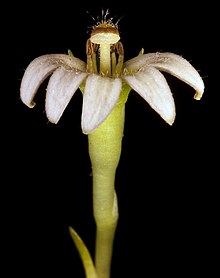Goodenia radicans
| Goodenia radicans | |
|---|---|

| |

| |
| Scientific classification | |
| Kingdom: | Plantae |
| Clade: | Tracheophytes |
| Clade: | Angiosperms |
| Clade: | Eudicots |
| Clade: | Asterids |
| Order: | Asterales |
| Family: | Goodeniaceae |
| Genus: | Goodenia |
| Species: | G. radicans |
| Binomial name | |
| Goodenia radicans (Cav.) Pers. | |
| Synonyms | |
| |
Goodenia radicans, commonly known as remuremu, swampweed, bonking grass, or its former botanical name Selliera radicans,[1][2] is a creeping, herbaceous plant species found in New Zealand, Australia and Chile. It is the most observed Goodenia on iNaturalist in New Zealand, and is indigenous to New Zealand and Australia.[3] Only one other Goodenia is native to New Zealand, the severely range-restricted Goodenia heenanii.
Description
A low-lying herb with short green leaves, which forms matted patches. It bears small white flowers.[4] G. radicans can grow to a height of 20 cm (7.9 in) and spread to 2 m (6 ft 7 in) wide. The shiny, narrow leaves can be up to 4 cm (1.6 in) long, and have a spoon shape. Small, fan-shaped white flowers are produced in summer.[1] It has been hypothesised to be the main host plant for the moth species Asaphodes frivola.
References
- ^ a b "Selliera radicans". Taranaki Educational Resource: Research, Analysis and Information Network. Retrieved 27 May 2012.
- ^ "Selliera radicans". New Zealand Plant Conservation Network. 11 August 2014. Retrieved 23 February 2017.
- ^ "Selliera (Goodenia radicans)". iNaturalist. Retrieved 8 September 2024.
- ^ "Goodenia radicans (Cav.) Pers". BiotaNZ. Retrieved 8 September 2024.
